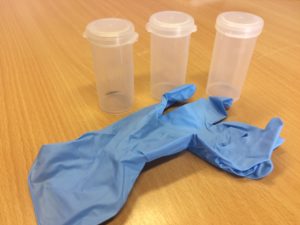Routine For Collecting Dung Samples
6 June 2017 Wearing a glove, collect fresh faeces (still warm) either from the rectum or the ground. Egg counts can be reduced in older samples due to hatching of eggs.
Wearing a glove, collect fresh faeces (still warm) either from the rectum or the ground. Egg counts can be reduced in older samples due to hatching of eggs.- A heaped teaspoonful per sample is sufficient but it is always better to have too much than too little. This can be used to check for both worm and fluke eggs.
- Sample 10 animals for routine monitoring.
- Sample animals in the same age and management group i.e. do not submit 5 samples from ewes and 5 samples from lambs for a single pooled egg count.
- Collect the samples into individual bags or pots. Write an ID on the bag/pot if appropriate and particularly if individual follow up testing may be required.
- Create anaerobic conditions to prevent eggs from hatching – remove air from the bag before sealing or fill pot to the brim with faeces.
- Store hygienically at 4°C if there will be a delay before posting to reduce the chances of eggs hatching.
- Please fill in as much information as possible on the submission form as this helps with interpretation e.g. age and dates of any recent treatment.
Kits including pots, bags and postage paid envelopes can be supplied if required.
Heather Stevenson, heather.stevenson@sac.co.uk
Sign up to the FAS newsletter
Receive updates on news, events and publications from Scotland’s Farm Advisory Service

